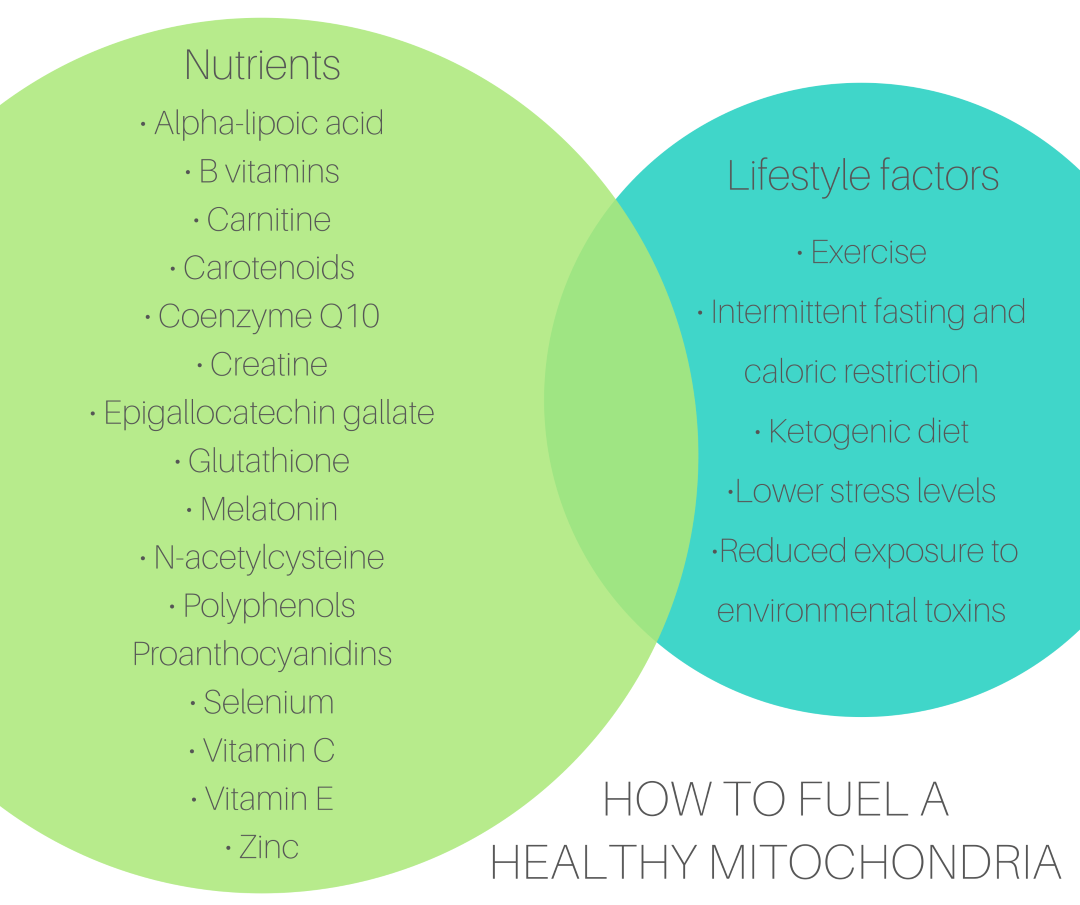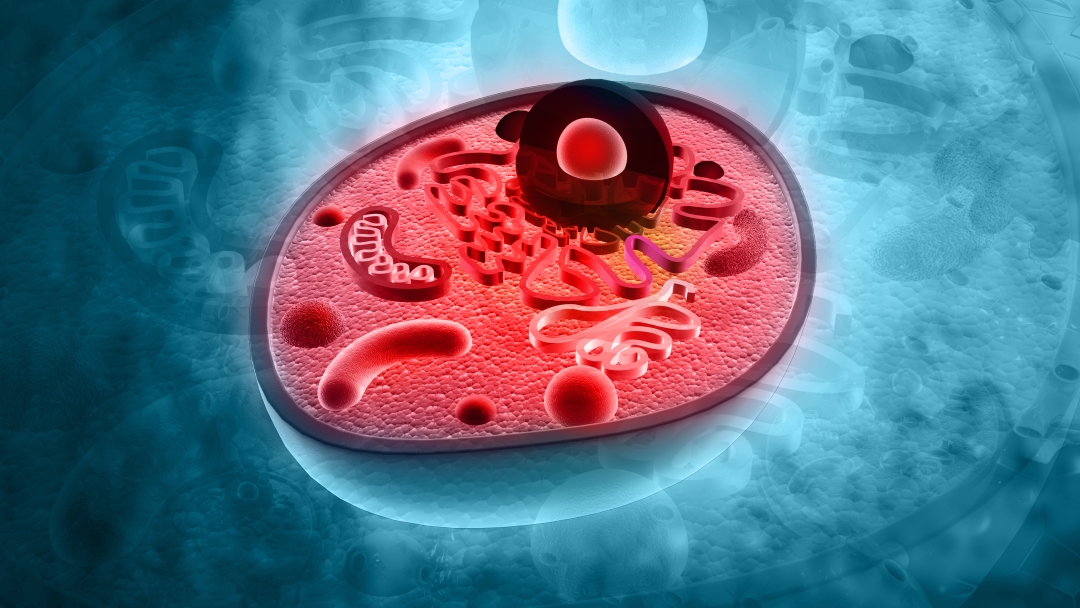Photo: Explode/Shutterstock.com
Although little, the mitochondria may just be one of the most important components of your cells. You may remember from high school biology that your mitochondria are the energy-producing organelle in your cells (“the powerhouse”). However, current research details the function of these organelles goes far beyond just energy production. Dysfunction in your mitochondria may also contribute to chronic disease, and it has been implicated in at least one theory of aging.
What’s the best way to keep your mitochondria healthy for optimal energy and wellness? Let’s see what the literature has to say.
Mitochondria 101
In case your basic biology is rusty, here are some bare basics of the mitochondria so we’re all on the same page:

Photo: By VectorMine/Shutterstock.com
Almost every cell has mitochondria, and some cells, such as your heart and muscle cells, have multiple mitochondria to handle the amount of energy required per cell. It is within this organelle that cellular respiration takes place to synthesize ATP (adenosine triphosphate), the energy molecule used in numerous body processes. The two main aerobic pathways, which are preferred since they create a higher number of ATP, include the citric acid cycle, also known as the Krebs cycle, and oxidative phosphorylation, also known as the electron transport chain.
The simplified formula for these reactions is that oxygen and glucose undergo a reaction that results with carbon dioxide, water, ATP, and ROS, or reactive oxygen species, which are free radicals or charged particles. Glucose does not have to be the only fuel source; protein and fat can be broken down to the molecule that goes through the Krebs cycle and oxidative phosphorylation to create ATP.
Several nutrients play vital roles in the production of ATP, especially the B vitamins and coenzyme Q10. In both the Krebs cycle and oxidative phosphorylation, the molecule NAD+, synthesized from either tryptophan or versions of niacin (nicotinamide, nicotinic acid, etc.), acts as an electron acceptor and donor at different stages. FADH2 does the same, and it is synthesized from riboflavin and two ATP. In the complexes involved in the oxidative phosphorylation process, CoQ10 aids in the transfer of the electron as part of the synthesis of ATP. Carnitine acts as a shuttle for fatty acids during beta-oxidation, the process that makes fats available for ATP synthesis.
As stated, free radicals are produced during this process. Although these play an important role in your body, including acting as signaling molecules, these free radicals can also cause damage. When your level of free radicals overwhelms the body’s capacity to handle them, known as antioxidant capacity, it creates what is known as oxidative stress. As with many things, a balance between free radicals and antioxidants is key to maintaining health. The free radicals also have the potential to damage the membrane through lipid peroxidation.
Glutathione is the main intracellular antioxidant your body can synthesize, and there are several others you consume in the diet: vitamins A, C, E, zinc, selenium, and many phytonutrients. In the past few decades, a lot of research has gone into antioxidants, due to the contributions that oxidative stress plays in many diseases and the potential for antioxidants to counter these problems. Preventing and reducing oxidative stress is more complex than just upping your antioxidant intake, but it does help.
Although energy and ROS production are vital functions of the mitochondria, there is a lot more to this organelle than this role. Additional functions of mitochondria include:
- Amino acid metabolism and homeostasis
- Apoptosis and autophagy regulation
- Calcium homeostasis and membrane potential
- Immune system function
- Iron metabolism and heme synthesis
- Lipid metabolism
- Regulators of neurotransmitter signaling
- Signaling molecules (ROS and H2O2)
- Steroid synthesis
- Thermogenesis
Mitochondria have their own DNA, known as mtDNA, and they are the only organelle to have their own DNA. Mitochondrial DNA is inherited through the mother, unlike nuclear DNA, which contains your genetic information that you have inherited from both parents. This is due to the mitochondria in the egg cell providing the mtDNA for the offspring.
mtDNA is more susceptible to damage (including mutations) than nuclear DNA, likely due to a lack of histones to protect the DNA from damage, the proximity of mtDNA to ROS production, limited DNA repair systems, limited proofreading capacity during replication, and ROS, reactive nitrogen species, and other products produced in the mitochondria that can damage the DNA.
Why Mitochondrial Health Matters
There are primary mitochondrial disorders, some of which have a genetic component. Mitochondrial diseases have a prevalence of an estimated 1:4300, which makes them one of the more common metabolism-related inborn errors. Fatty acid oxidation disorders also have a mitochondrial dysfunction element to their pathophysiology.
Even the majority of the population who have a genetic capacity for healthy mitochondria can end up with dysfunctional mitochondria contributing to disease. Damage due to environmental toxins, especially an accumulation of pollutants, poor sleep, chronic stress, hyperglycemia, oxidative stress, copper toxicity (especially the brain mitochondria), heavy metals (such as nickel), and other factors lead to a loss of function.
This may present in a few ways: a lower number of mitochondria than necessary, inadequate levels of the necessary substrates for performance, damage to the membranes, or problems that lead to dysfunction in the ATP synthesis. The result is a decrease in ATP or cellular energy, an increase in free radicals, and an increase in the reliance on alternative pathways for energy synthesis. Any or a combination of these problems can create health problems.
The symptoms of mitochondrial problems and related disorders go far beyond fatigue issues, although that is one of them. Poor mitochondrial function has been linked to:
- Aging
- Alzheimer’s disease
- Atherosclerosis
- Bipolar disorder
- Cancer
- Cardiovascular disease
- Chronic fatigue syndrome
- Chronic kidney disease
- Depression
- Diabetes
- Fatty liver disease
- Fibromyalgia
- Infertility and reproductive problems
- Inflammatory bowel disease
- Insulin resistance
- Multiple sclerosis
- Neurodegenerative disorders
- Non-alcoholic fatty liver disease
- Obesity
- Parkinson’s disease
- Psychiatric disorders
- Skin disorders
How to Nourish the Mitochondria
There are many different components for nourishing the mitochondria for optimizing health. First, it is beneficial to recognize the areas in which one may be susceptible to problems. This may be damage due to environmental toxins or one of the other damaging items listed above, including poor sleep, lack of exercise, and a poor diet.
Next, it is important to know which nutrients feed the mitochondria for maximum health.
A good place to start is ensuring you have adequate levels of the substrates and coenzymes necessary for mitochondrial functions, namely energy production:
- B vitamins – the different B vitamins all play a key role in mitochondrial function and energy production, and a deficiency in any may contribute to dysfunction.
- Thiamine (B1) plays a role in the citric acid cycle and increase the catabolism of pyruvate to acetyl-CoA to start the cycle.
- Riboflavin (B2) plays a role in the respiratory chain
- NAD+ or NADH, a key component of oxidative phosphorylation, is synthesized from niacin (B3). Although niacin supplementation may help, some have started to supplement with nicotinamide riboside, an NAD+ precursor, and NADH. In one open-label study, those taking 1,000 mg of NR twice daily experienced an increase in NAD+ serum levels. In another study, a combination of NADH and CoQ10 supplementation led to an improvement in experienced cognitive fatigue and overall fatigue perception in patients with chronic fatigue syndrome.
- Pantothenic acid (B5) is part of Coenzyme A and plays a role in beta-oxidation.
- Pyridoxine (B6) can act as an antioxidant to prevent lipid peroxidation and also plays a key role, including as a cofactor in many enzymatic reactions, in amino acid metabolism.
- Biotin (B7) is also required for fatty acid oxidation and gluconeogenesis as a coenzyme.
- Folate (B9) is necessary for the maintenance of mtDNA health, as well as a key role in one-carbon metabolism along with many of the other B vitamins. Although many one-carbon functions take place outside of the mitochondria, it also impacts many key functions within including the production of NADH and antioxidant balance. Around a third to a half of folates are located in the mitochondria.
- Cobalamin (B12) also plays a role in mtDNA health and plays a role in amino acid synthesis, as well as fat and carbohydrate metabolism.
- Carnitine (L-carnitine or acetyl-L-carnitine) – this nutrient is crucial for beta-oxidation, or the breakdown of fatty acids into energy. Carnitine aids in the transport of acyl Co-A, the end product of fat breakdown that enters the beta-oxidation process to become acetyl-CoA, which is used in the Krebs cycle to create ATP energy, across mitochondrial membranes. Beta-oxidation is a key component of energy homeostasis, as fatty acids are an important energy source for anyone, not just those who consume a lot of fat. A mouse study found that supplementing with L-carnitine led to upregulation of beta-oxidation and prevented the progression of non-alcoholic steatohepatitis, a form of non-alcoholic fatty liver disease. Another mouse study found that taking acetyl-L-carnitine reduced the negative impact of arsenic, including improving mitochondrial function and reducing oxidative stress.
- CoQ10 – CoQ10 is a lipophilic molecule that sits in the membrane and acts as an electron carrier in the complexes that are part of oxidative phosphorylation. It also acts as an antioxidant and has a few other functions. CoQ10 is one of the more studied supplements for mitochondrial support. In one cell study, human corneal epithelial cells treated with varying levels of CoQ10 formulas demonstrated a reduced rate of apoptosis and increased rate of metabolic activity in human endothliai cells.
- Creatine – creatine acts as a buffer from ATP and helps to shuffle the high-energy phosphates from the mitochondria to the cytoplasm.
Another key category of mitochondrial nutrients is antioxidants. As discussed, these help maintain a balance between the ROS production and antioxidant capacity to prevent and reduce oxidative stress and associated dysfunction and disease. Some of the key antioxidants researched in combination with mitochondrial health include:
- ALA (alpha-lipoic acid) – In one study on male rates dosed 60 mg/kg of ALA after being exposed to reduced TNF-α and IL-6 levels (markers of inflammation), reduced levels of lipid and protein peroxidation, and increases in both glutathione levels and the GSH/GSSG ratio (a reflects the intracellular glutathione redox balance and is indicative of cellular health) were observed. In a study looking at 79 chronic migraine sufferers administered 600mg per day of ALA for 3 months, beneficial effects on mitochondrial and endothelial function were demonstrated. While the causes of migraines may vary, one aspect of pathophysiological factors may be mitochondrial dysfunction.
- Carotenoids – especially lycopene
- Epigallocatechin gallate (EGCG; green tea) – Cellular homeostasis, free radical scavenging activity, and metal chelation decrease the accumulation of lipid peroxidation and improve mitochondrial biogenesis.
- Glutathione – the major intercellular antioxidant
- Melatonin – this hormone does more than just regulate your sleep/wake cycle; it is also a potent antioxidant, reducing oxidative stress and inflammation.
- NAC (n-acetyl cysteine) – a precursor for glutathione synthesis
- Polyphenols – Quercetin, resveratrol, hydroxytyrosol (found in olives and olive oil) – these scavenge ROS, modulate mitochondrial biogenesis, uncouple oxidative phosphorylation and modulate MPTP opening, affect ATP synthesis, and regulate apoptosis
- Proanthocyanidins – additional antioxidant phytochemicals found in plant foods
- Selenium – in the right balance, selenium protects against oxidative stress. However, excessive selenium may cause a problem.
- Vitamin C – another key antioxidant to protect against oxidative stress.
- Vitamin E – in a mouse study, vitamin E supplementation, especially alongside CoQ10 supplementation, led to a decrease in age-associated functional impairments as well as a reduction in the carbonyl content in the mitochondria of the brain, liver, and skeletal muscle in those supplemented with either CoQ10 or the combination of the two.
- Zinc – zinc plays a role alongside calcium in mitochondrial redox regulation in addition to being an important antioxidant. However, like selenium, excessive zinc may contribute to oxidative stress rather than alleviate it. In one rat study, selenium and zinc effectively reduced oxidative stress and chronic inflammation induced by obesity..
As mentioned, there are also some key lifestyle factors that add to the overall health of the mitochondria. Some of the main ones to consider in regard to mitochondrial health include:
- Exercise – With some mitochondrial disorders, you may need to do so under the guidance of a doctor or professional, as exercise intolerance is common. However counterintuitive it may seem, the beneficial stress of exercise helps build stronger mitochondrial, although excessive exercise may contribute to the problem.
- Intermittent fasting and caloric restriction – one review found that the results of caloric restriction in terms of mitochondrial health varied from study to study, but generally there was a decrease in ROS generation. Some studies found an increase in mitochondrial biogenesis and there was an increase in Sirt3, which modulates the activities of different mitochondrial enzymes.
- Ketogenic diet – the ketogenic diet has been shown to decrease the number of ROS and other free radicals created by the mitochondria.
- Lower stress levels – mitochondria can sense and react to stressors. This may be one reason for excessive stress, whether from work or social or relationship stress, contributes to chronic disease. Finding ways to reduce stress and incorporating stress-relief exercises, including mindfulness and meditation, can be a key component to helping with your overall health, as well as that of your mitochondria.
- Reduce your exposure to environmental toxins

In addition to these three categories, there are some studies pointing to additional herbs and substances that may also help with mitochondrial health:
- Curcumin (turmeric) – prevents, protects, and increases recovery rate from cardiovascular-related events
- Taurine – regulates mitochondrial protein synthesis, which then enhances the capacity of the electron transport chain and protects against oxidative stress
- Yerba Mate – stimulates biogenesis of mitochondria
Many of the studies looking into the beneficial substances mentioned above remain at the in vitro and animal study level, meaning it may not be the same in clinical practice as it is in the lab, like many things. However, a few key takeaways exist as to the vital elements for healthy mitochondria: antioxidants, B-vitamins, colorful foods, and polyphenols.
The consensus for the care for primary mitochondrial disorders from the Mitochondrial Medicine Society includes special care during bouts of illness or surgeries requiring anesthesia, as well as a few vitamins and nutrients commonly used in practice, despite limited research validating the use:
- ALA
- B vitamins, especially riboflavin and folinic acid
- CoQ10
- Endurance exercise using a combination of resistance and progressive exercise under supervision starting with low-level training.
- L-carnitine
Food First Approach: Diet to Improve Mitochondrial Health
There are some things you can do based on what the literature has demonstrated so far. As a foundation, a good place to start is with a colorful, plant-based diet filled with whole, organic foods.
Here are some ideas on foods and drinks that can help you start optimizing your mitochondrial health:
- Green tea
- Foods rich in ALA: beets, broccoli, Brussel sprouts, carrots, organ meat, and tomatoes.
- Foods rich in B vitamins, especially meats, nuts, organ meats, and seeds.
- Foods rich in carnitine: asparagus, beef, and chicken
- Foods rich in CoQ10: broccoli, cauliflower, fish, lentils, meats, organ meats, sesame seeds, soybeans, spinach, and strawberries.
- Foods rich in selenium (brazil nuts, chicken, eggs, pork, tuna, and turkey) and zinc (adzuki seeds, pumpkin seeds, sesame seeds, oysters, and turkey)
- Plenty of colorful vegetables and fruits for lots of antioxidants and phytonutrients, especially carotenoids, resveratrol, quercetin, and proanthocyanins. Some examples include almonds, apricots, asparagus, avocado, bananas, beets, carrots, grapefruit, grapes, guava, kale, onion, oranges, pecans, pumpkin, quinoa, rutabaga, spinach, strawberries, tomatoes, and watermelon.
- Spices, especially basil and turmeric.
Those who feel as though they need additional support beyond the diet can look into mitochondrial support in supplemental form, such as the more studied ALA, carnitine, and CoQ10. Talk with your doctor, nutritionist, or another healthcare practitioner to discuss the best options for your individual circumstances.






fantastic article and advisory. what a research. so clear and understandable.and there is more. to the left and to the right.so helpfull.thank you very much.